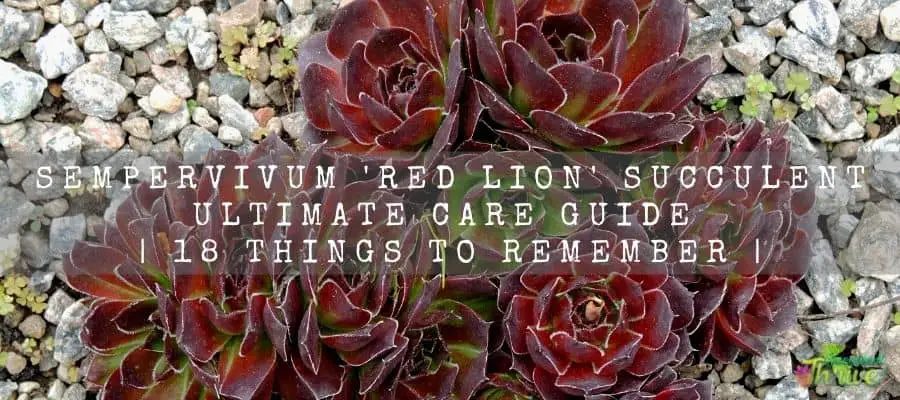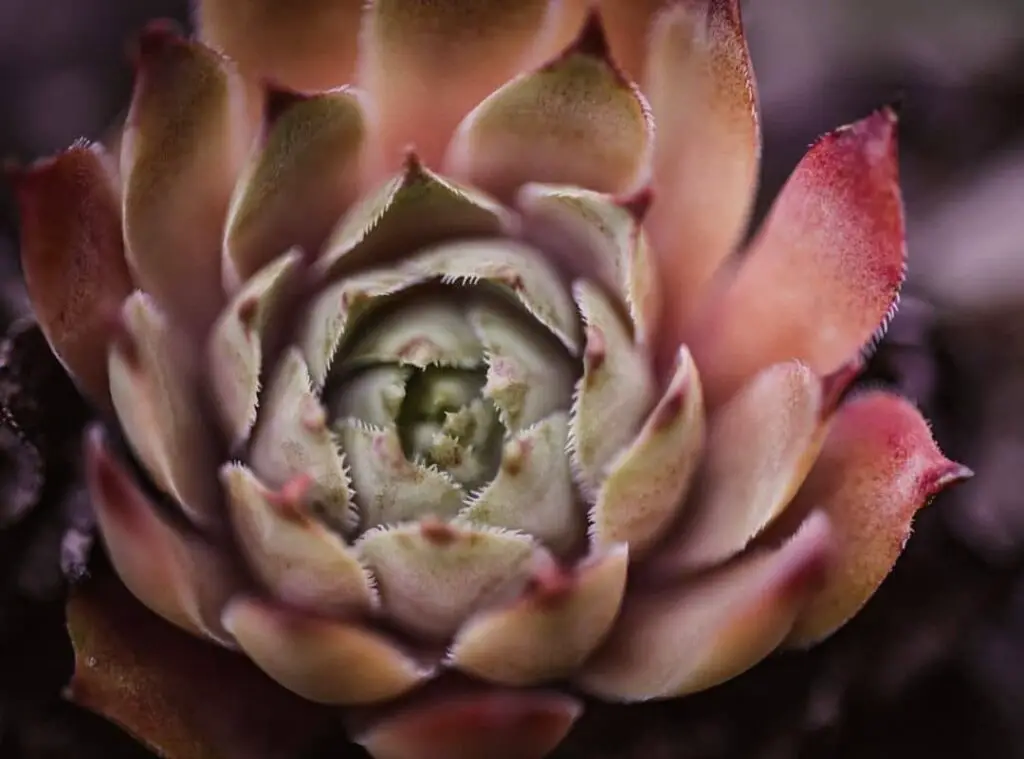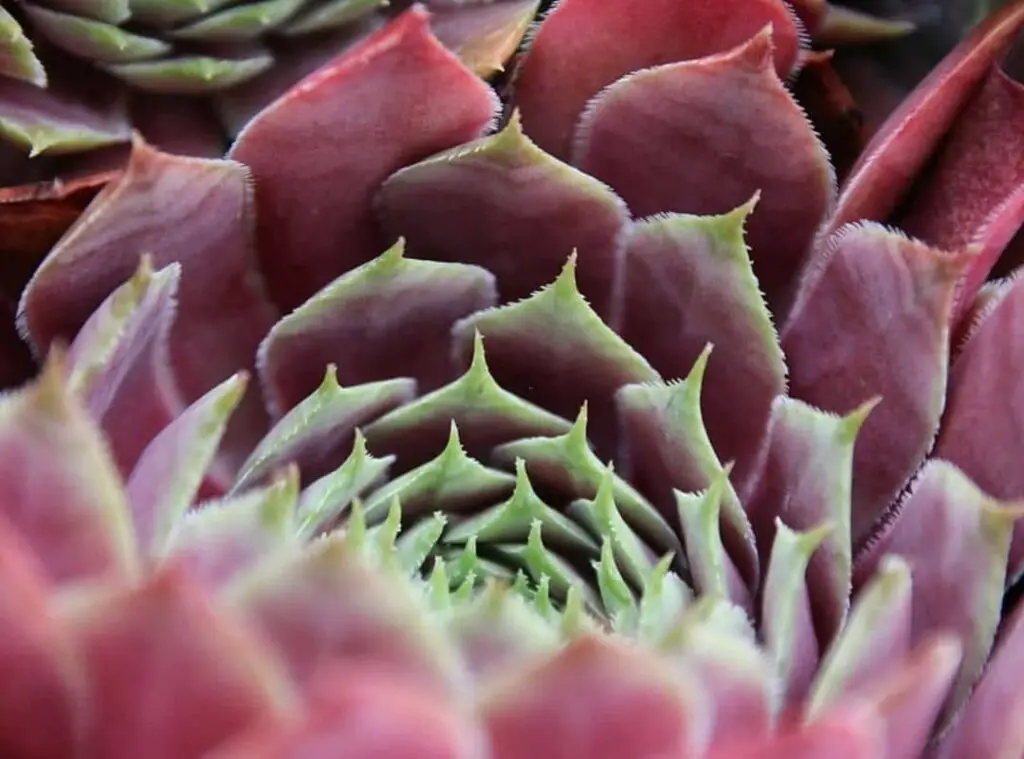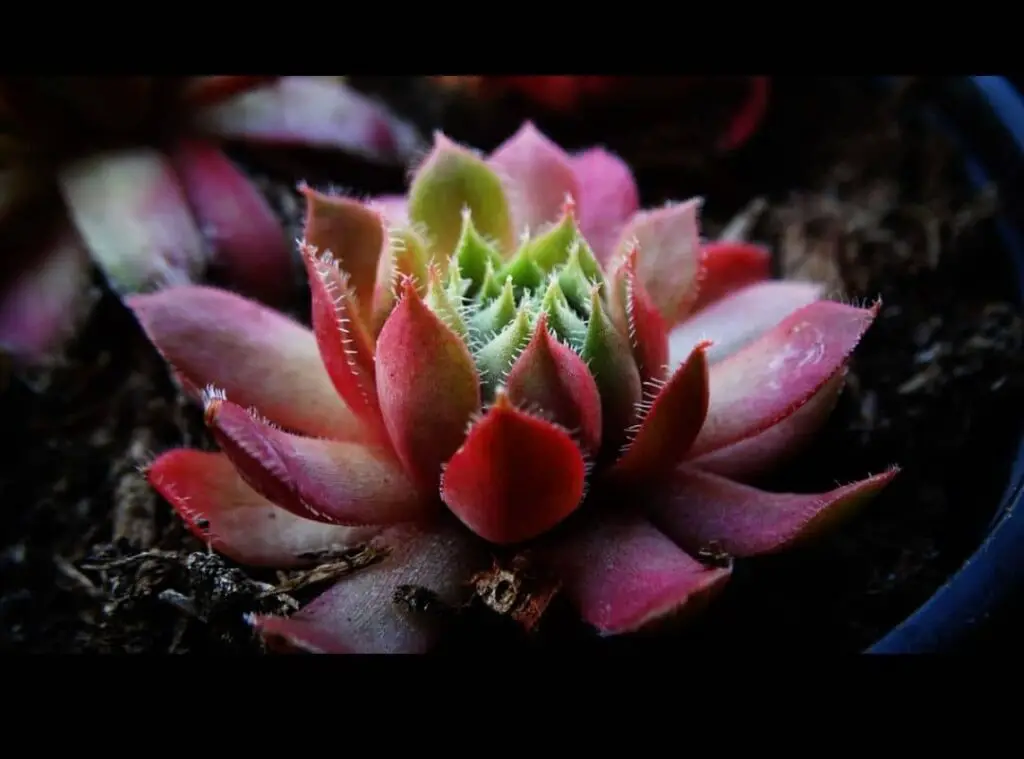Are you looking for a succulent which has a touch of red for your garden? Then, Sempervivum red lion would suit your requirement the best.
Sempervivum red lion is a perennial succulent. Further it would look fantastic in containers as well.
In addition to that if you live in a colder area and looking for an outdoor plant, Sempervivum red lion could fulfill your requirement.
They only require minimum maintenance. As such it would perfectly fit in for a forgetful gardener. Moreover their propagation is simple too.
Hen and chicks red lion is a common name of these plants. Sempervivum red lion is a hybrid formed by Andre Smits in 1994. Country of origin of these plants is Belgium.

How do I identify a sempervivum red lion?
You could identify the Sempervivum red lion from its beautiful leaves. Further they will produce rosettes in bright red.
Moreover, there will be silver cilia along their leaf tips as well. You could identify them from their flowering as well.
They would produce showy flowers during late summer or early fall.
Size
In terms of their sizes, they would be about ½’ to 2 ½ ‘.
Growth
Sempervivum red lion plants tend to grow at a moderate rate.
One look care guide
| Botanical Name | Sempervivum ‘Red Lions’ |
| Common Name | Hen and chicks red lion |
| Plant Type | Succulent |
| Mature Size | ½’ to 2 ½ ‘ |
| Sun Exposure | Full Sunlight to Partial sunlight |
| Soil Type | Well-draining |
| Soil pH | Neutral |
| Bloom Time | late summer or early fall. |
| Flower Color | Showy |
| Hardiness Zones | USDA hardiness zones 4a-6a. |
| Native Area | Belgium |
| Toxicity | Non |
| Average price | 5 USD |
How do you take care of the Sempervivum red lion?
Light Requirement
Sempervivum red lions could thrive in a wide array of lighting levels. Be it bright sunlight to partial shade.
However best is to expose them to plenty of sunlight. In other words, best is to expose them for full sunlight in the morning and then expose them for partial shade during afternoon hours in summer.
On the other hand, if you grow them as indoor plants, you should be extra careful to provide them adequate sunlight levels.
Reason for that is indoor lighting is not that great when compared to the outdoor conditions.
As such if you ever come across any leggy growth of these plants or if you spot any discoloration, it could be a result of lack of sunlight.
Having said that, if you are growing them indoors, I would suggest you locate them near a bright sunny window.
However, you need to protect the plants from intense heat levels, particularly if you have placed them near a glass window.
In that circumstance you need to immediately shift them outdoors or keep rotating them from indoors to outdoors.
However, when you bring them outdoors, you should slowly acclimate them to bright sunlight. Unless the plant will be traumatized and could create sunburns.
Temperature and humidity
Best is to grow them in a temperature range of 65 degrees Fahrenheit – 75 degrees Fahrenheit.
In terms of moisture, they would prefer to grow in dry to medium humidity conditions,
Is it cold hardy?
Sempervivum Red Lion plants are cold hardy. As such if you are someone who lives in colder weather conditions and wondering what to grow in your garden, Sempervivum Red Lion could be handy.
Sempervivum Red Lion could tolerate a minimum cold temperature of (-30 °F) to (-5 °F)
Zone
Sempervivum Red Lions are hardy in USDA hardiness zones 4a-6a.
Watering Requirement
Sempervivum Red Lion’s water requirement is very minimal. These are used to grow in hot and dry weather conditions.
As such you could water them less often. However, when you water them ensure you soak the plants with water and let them dry.
Once a month watering would be adequate for them during hot and dry weather conditions.
Further you should water them even less when you water them in winter conditions. If you end up watering more during the winter season, it will create severe repercussions such as root rot.
They would be great picks for rockeries, scree beds and for containers. Do not ever let them stand in waterlogged conditions though.
The most crucial thing you need to keep in mind when watering them is to allow the soil to dry and only after that to water them.
If you are unsure whether you should water these plants or not, best is to wait for some time and then water.
Usually underwatering causes less damage rather than over watering.
You can also revive an under watered plant from a couple of drinks of water. On the other hand, reviving an overwatered plant would be very hard.
Further you should grow them in a soil mix which has good drainage. Unless excess water will retain the potting medium.
further ensure that you are growing them in a pot which has enough draining holes so that excess water will not be retained in the pot.
Moreover, always keep checking your plant on a regular basis and see whether you could spot any signs of over watering or under watering. If you come across any, you need to immediately attend to them.

Soil Requirement Type / pH
When it comes to selecting the right soil mix, you should always go for a dry well draining, loamy sandy light soil mix.
Alternatively, you could go ahead with a cactus soil mix or with a succulent soil mix to grow these plants when you are growing them in pots.
On the other hand, if you grow them in a garden bed, you should check whether the soil there is too dense.
If it is too dense, best is to amend it by adding elements such as coarse sand, pumice, or gypsum. That will enhance the draining of the soil medium.
Generally, Sempervivum Red Lions are fond of growing well-draining nutrient low soil mix. Best is to have a soil mix which has a neutral ph.
On the other hand, you may grow these plants in a poor sandy soil mix if you grow them outdoors.
Flowering and Fragrance
Sempervivum Red Lions would produce showy flowers during late summer or during early fall.
Pot size Potting and Repotting
When it comes to selecting the right pot, best is to grow them in a porous pot. When you grow them in porous pots, it would allow the plant to dry faster without retaining excess water within the pot.
In terms of repotting, best is to conduct the repotting during the start of spring. Other than that, you need to consider repotting them once you freshly purchase them from the stores.
To start off you have to first take out the plant from its pot once their soil is dry.
Get ready with a proper pot which fulfills the aforesaid requirements. After that, fill the pot with the right soil mix partially. Now get rid of the older soil of the plant.
Have a closer look whether your plant is healthy and whether there are any rotten parts of the plants. if there are any get rid of them as well.
You may now plant it in the fresh soil mix and keep on adding soil until the plant stays stable. You could compress the soil to see whether the plant stays firm in the pot.
Ideally you have to grow it in the same depth in which it was initially grown
You could consider adding a top dress of grit or small gravel whilst ensuring that grit is placed underneath the rosette base.
It will avoid the plant crown sitting in any waterlogged situations. Skip watering them for about one week’s time so that you could avoid any potential root rot. After that you may water them as aforesaid.

Where to Plant
Sempervivum Red Lions are hardy plants. Hence, they could thrive well anywhere you plant them.
You could grow them in shallow soil. further you may grow them in gaps in the stone walls or in gravel beds as well. Alternatively, you may let them drape over rocks too.
When you grow them on the green roofs, you do not have to bother in watering them. Sempervivum Red Lions are a versatile and resilient plants.
However, you need to be vigilant on their right growing conditions when you grow them indoors or outdoors.
Fertilizer and time of year
Sempervivum Red Lions are not heavily dependent on fertilizers. They are quite used to growing in poor soil.
Having said that, you could consider feeding them during spring as the plant’s growth will be benefited from that.
To feed them, you may select a controlled release fertilizer. Once a year feeding them would be adequate.
Ensure that you do not overfeed them unless it could result in leaf color dislocations and in stunt growth.
Dormancy
They would usually go dormant below freezing temperatures.
Other plants Pairs Well With
Sempervivum Red Lions would grow well with Sedum plants and with Sempervivum plants
Can it be toxic to pets?
Sempervivum Red Lions could be lightly poisonous for pets. Chances are that it could create minor skin irritation for some people.
Handling the plant
You need to handle these plants in such a way where you do not over water them.
Further expose them for adequate sunlight and grow them in a right soil mix. If you adhere to these guidelines, they will reward you with vigorous plants in return.
Common bugs and illnesses
Sempervivum Red Lions are usually resistant towards pests. However, there could be certain issues where these plants suffer from over watering.
As you may know Sempervivum Red Lions are used to grow in hot and dry weather conditions.
Hence if you provide them water abundantly it could make the plant more vulnerable for root rots and for pest’s infestations.
In addition to that they may also come across mealybug attacks as well. As such you need to always conduct constant checkups on your Sempervivum Red Lions plants and see if there are any signs of pest’s infestations.
If you come across any pest’s infestation, you should attend to them with a systemic insecticide solution or with neem oil.
In addition to that you could use isopropyl alcohol to drench soil and to overcome the pests living in the soil. Moreover, you may rub the affected leaves with rubbing alcohol.
Apart from that you could use cotton swabs and dip them in rubbing alcohol and clean the leaves of the plant.
Special Care tips
It is vital that you provide the right growing conditions of these plants. Apart from that, constantly keep checking your plants and see whether the plant is showing any sign of disease.
Make sure the plant’s surrounding area is kept clean too

How to propagate sempervivum red lion
Sempervivum Red Lions usually produce offsets, and they would grow up to be smaller plants along with fragile small roots. When they are in their natural habitat, they will segregate from the mother plant and will start rooting as they wish. It is very easy.
However, when you grow them indoors, you could simply take off their offsets and plant them in a shallow pot in which you have added a well-draining soil mix.
Moreover, you may use their leaves and cuttings to propagate the Sempervivum Red Lions.
Just like you do with other succulents, you simply have to obtain those and keep them in a dry place where they can become callous.
You need to leave them like that for about one week’s time. After that you may place them in sand and wait until they form little offsets.
Start watering the specimen when the soil is dry during spring and in summer. Avoid watering them during autumn and in winter.
Further avoid feeding them during this process.
Sempervivum red lion plant benefits
Sempervivum Red Lions are useful as ground covers even if you live in colder weather conditions. They would be useful to fill the gaps in the stone walls as well.
If you have any uncommon spots where there is little soil or no soil at all, they would be handy for those places as well.
Conclusion
Before wrapping this up, I hope this article was useful for you and trust now you are much more confident in handling the Sempervivum Red Lions plants in a smooth way.
As you may now understand they are versatile plants, and you only need to ensure that you fulfil the right growing conditions.
As such, anybody would love to grow one of these plants. So, hurry up! Start growing these wonderful plants and get that amazing experience on your own. Happy gardening
Read Next: Jellyfish Air Plant | A Beautiful Combination of Nature And Creativity |


